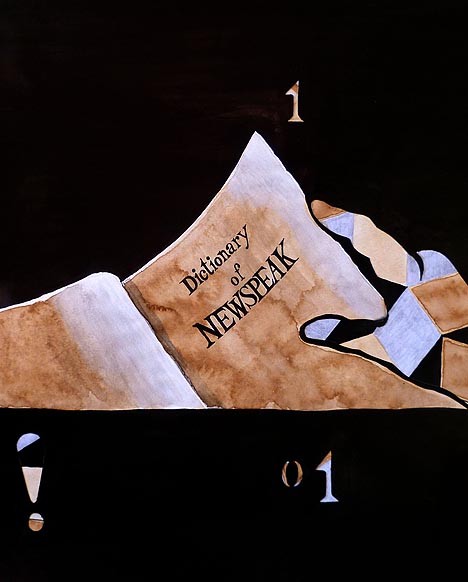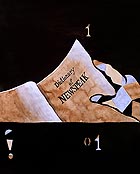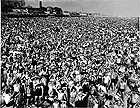
translated and summarized by: Liz Wollner-Grandville,
English summaries November 28 - December 11
Fondation Beyeler
Louise Bourgeois
03.09.11 – 08.01.12
Dialogue between the (un)like
On the occasion of Louise Bourgeois’ 100th birthday the Fondation Beyeler is presenting some of her key works – among them the famous Passage Dangereux, the 220 Insomnia Drawings and the monumental spider Maman. Yet the exhibition in Basel is not a large retrospective; Á l’infini shows a selection of Bourgeois’ works and compares them to the “Grand Masters” of modern art such as Cézanne, Picasso or Barnett Newman. The obvious thesis of the exhibition: Bourgeois’ dialogue is at eye level with her important – and exclusively male – colleagues.
With Red Fragmented Figure and Ferdinand Léger’s Contraste de forms two works with a similar cubistic dynamic are juxtaposed; the Waiting Hours, a series of geometrical patchwork compositions is positioned next to the asymmetrical colour formations of Ellsworth Kelly’s Blue Black Red Green; and her work In Respite, a rack made of cotton reels and an amorphous pink body maltreated with needles, shares the room with Francis Bacon’s Lying Figure.
This kind of formal aesthetic closeness proves to be a blessing and a curse for Bourgeois. Some comparisons turn out to be a platitude – for example when Bourgeois’ Cell XVII – a bust in a cage – is presented next to Giacometti’s nearly identically composed La Cage – and the former no longer being more than a course citation of the other.
On the other hand, the reduction to the formal liberates Bourgeois from the oozing severity of her psychoanalytical-autobiographical interpretation – even if this is undeniably justified, it has turned into a tagged one-dimensionality. Praising Bourgeois’ work for its aesthetic quality without the usual ‘childhood traumatic’ translation is a real treat.
Where the redundant path of viewing Bourgeois’ work fades into the background it makes way for new layers of meaning of her work. Nevertheless, Bourgeois’ oeuvre contextualizes the work created by her male colleagues in a critical way and reminds of the gender specific price for existentialism and minimalistic abstraction.
By Ines Kleesattel
Fondation Beyeler
4125 Riehen / Basel, Baselstrasse 101
Tel: +41 (0)61 645 97 00
Fax: +41 (0)61 645 97 19
Email: foundation@beyeler.com
www.beyeler.com
Opening hours: Mon – Sun 10 – 18 hours, Wed 10 – 20 hours
Startgalerie im MUSA
Robert Freund – Everything Counts in Large Amounts
18.11.11 – 15.12.11
Between Graphic Novel and Renaissance Print
The comic-like ink drawings with their somewhat rough and partly awkward lines immediately remind of Raymond Pettibon, but in a strange way also of the early days of European print graphics as they can be found in Schedel’s Nuremberg Chronicle. One can find beasts reminding of flying fish side by side with the popular vanitas-motifs in the form of a mirror showing a skull. In a deeper sense both of these worlds, that of modern comics and that of early commercial graphics - even if they are far apart - match perfectly as both essentially want to narrate something and offer an inseparable unit with the text. Yet Robert Freund, born 1981, relates to a completely different narrative: he quotes from art and cultural science. As for example in his disc shaped portrait of the art theoretician and social reformer John Ruskin, which, on account of the hand-carved beechwood frame, has a special reference to the ideas of this pioneer of the arts and crafts movement.
Even the painted ceramics that remind of Chinese Ming Dynasty porcelain at first glance seem to be decorative everyday objects rather than distinct pieces of art. Like all works presented here they are successfully linked to the intersection between “pop-culture” and “fine arts”.
One can visit this show to experience a pure aesthetic pleasure or its numerous intellectual references and insinuations, or even better – to experience both.
By Wolfgang Pichler
Startgalerie im MUSA
1010 Vienna, Felderstrasse 6-8, next to the town hall
Tel: +43 (0)1 4000 8400
Email: musa@musa.at
www.musa.at/stargalerie
Opening hours: Tue, Wed, Fri: 11 – 18 hours, Thu 11 – 20 hours, Sat 11 – 16 hours
Westlicht, Schauplatz für Fotografie
Weegee – Retrospective 1932 – 1960
22.11.11 – 12.02.12
The vulgar modernist
Nighttime in New York, a drunkard sleeping on the curb stone, an undertaker next to him. Cigarette smoke gets more and more intensive as Arthur Fellig, called Weegee, who practically smokes all the time and everywhere, arrives next to the drunkard. He takes his camera, contemplates, and shoots. An icon of photography has just emerged.
Some say he was an opportunist, others believe that he made his photos to document the reality in the slums. The truth is probably somewhere inbetween. A small portion of Fellig’s thousands of photos is now displayed in the Westlicht exhibition.
Two stand out at the entrance: on the left a man in an elegant suit, next to him a photograph showing two ladies in evening dresses. The same scenery? Definitely not - the man is a poor sales agent and just leaving church; the ladies are on their way to the opera.
Among the displayed works is also one of his most beautiful photographs: Coney Island, 1945. The photo shows Coney Island beach crowded with people - most of them staring at his camera. His assistant Louie Lotta said Weegee climbed onto a platform and danced and screamed until enough eyes were staring at him before he took the picture.
In 1945, he started to produce distorted photographs with the help of special lenses, mirrors, textured glass and melted Plexiglas. This period is often left out but luckily some of these works are shown here. Now it’s not him taking a picture of distorted reality but him distorting something - no matter if it's Dali or Marilyn Monroe.
Weegee was a member of Cinema 16, the legendary film club founded by Amos Vogel. When Vogel heard that Weegee also filmed he asked his permission to compile the material to a film. The material is remarkable and reminds both of his early as well as his later work.
Even if Weegee’s later films are not shown and some of his more well known works are not presented at this exhibition it doesn’t really matter. The arrangement of the works and the context by far exceed the expectations for Weegee’s first exhibition in Vienna.
Patrick Schabus
Westlicht. Schauplatz für Fotografie
1070 Vienna, Westbahnstrasse 40
Tel: +43(1) 522 66 36 – 0
Fax: +43 (1) 523 13 08
Email: nfo@westlicht.com
www.westlicht.com
Unteres Belvedere
Curt Stenvert NEODADAPOP
05.10.11 – 15.1.12
An international 20th century artist from Austria
The solo exhibition in the Orangerie (Lower Belvedere) is currently devoted to the versatile artist Curt Stenvert and at the same time Manfred Lang is presenting individual works by Stenvert in his gallery on Seilerstätte, including collages, show cases and sculptures.
In 1920, Curt Stenvert (nee Kurt Steinwender) was born in Vienna and changed his name in 1969. Stenvert grew up in a worker’s family in Vienna and his mother died when he was very young. He began his studies in 1942 under Karl Sterrer at the Vienna Academy of Applied Arts and was forced to interrupt his studies several times during the war. On account of his grandfather’s Russian origin he was often confronted with the horrors of the Nazi regime.
But before he dealt with the atrocities and absurdities of war – see his sculpture “Stalingrad”, 1967 - he focused on motion sketches, which he conducted in a constructivist and cubistic style. The Belevedere shows a violin player that is comparable to Miro’s motion studies. The influence of Viennese kinetic art, e.g. by Erika Giovanna Klien plays an equally important role as Laszlo Moholy-Nagy. Soon he turned to film and founded a production company together with his second wife in 1957. His first experimental film “The Raven” (1951) is shown at the Belvedere. “Viennese women in the shadow of a metropolis” (1951/1954) is a bitter critique on the immiseration of women on the fringe of society that did not appeal to post-war Austria, while it was widely acclaimed abroad.
His ability to stage figures and dolls dramatically was clear in his work in 1967 “Stalingrad – The Return on Investment of a tyrannicide”. This work consists of three showcases displaying skulls and wolf men in military uniforms eating brains, surrounded by the remains and dirt of combat. Stenvert attempts to show how many lives could have been saved through a targeted tyrannicide in the 1940’s. The work that conveys the misery and ugliness of war in all of its abnormality has a didactic connotation – similar to the Fluxus Art of Wolf Vostell or Richard Lindner. In 1967/68 his showcases were presented at numerous occasions in Paris. Today, they are located in Vienna’s Military History Museum.
In the 1970’s, the artist devoted himself more to painting and developed a “bio-cybernetic manifesto”. The range of Stenvert’s work is extremely colourful and intensive.
Stenvert died in 1992. The current exhibition in the Belvedere attempts to honour an artist who was at the pulse of his time. He combined important international artistic movements with his works and came up with independent artistic solutions. He had a humanistic education and experienced and survived the horrors of the war and the Nazi regime. His films showed a different picture of Austria during the 1950s. The Belevedere offers a good, primarily historic impression, of this exceptional artist, while the exhibition in the Gallery Lang is artistically enlightening.
By Susanne Rohringer
Galerie Lang Wien
1010 Vienna, Seilerstätte 16
Tel: +43 1 512 20 19
Fax: +43 1 512 02 37
Email: glw@glw.at
www.glw.at
Opening hours: Tue – Fri 12 – 18 hours, Sat 11 – 17 hours
Unteres Belvedere
1030 Wien, Rennweg 6
Tel: +43 1 795 57-200
Fax: +43 1 795 57-121
email: info@belvedere.at
www.belvedere.at
Opening hours: Daily between 10 and 18 hours, Wed 10 – 21 hours
Mehr Texte von translated and summarized by: Liz Wollner-Grandville


 Teilen
Teilen



